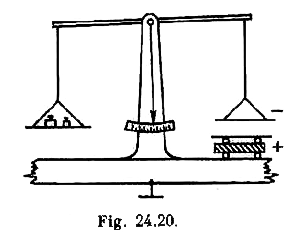Consider a thin spherical shell of radius R consisting of uniform surface charge density σ. The electric field at a point of distance x from its centre and outside the shell is
inversely proportional to σ
directly proportional to x2
directlr proportional to R
inversely proportional to x2
The correct Answer is:D
To find the electric field at a point outside a thin spherical shell with uniform surface charge density σ, we can follow these steps:
1. Understand the Setup: We have a thin spherical shell of radius R with a uniform surface charge density σ. We need to find the electric field at a point located at a distance x from the center of the shell, where x>R.
2. Use Gauss's Law: According to Gauss's law, the electric field E due to a symmetric charge distribution can be calculated using the formula:
ΦE=∮→E⋅d→A=Qencϵ0
where ΦE is the electric flux, Qenc is the charge enclosed by the Gaussian surface, and ϵ0 is the permittivity of free space.
3. Determine the Enclosed Charge: The total charge Q on the spherical shell can be expressed in terms of the surface charge density σ and the surface area of the sphere:
Q=σ⋅A=σ⋅4πR2
4. Choose a Gaussian Surface: For a point outside the shell (at distance x), we can choose a spherical Gaussian surface of radius x. The electric field E will be uniform over this surface due to symmetry.
5. Calculate the Electric Flux: The electric flux through the Gaussian surface is given by:
ΦE=E⋅4πx2
6. Apply Gauss's Law: Setting the electric flux equal to the charge enclosed divided by ϵ0:
E⋅4πx2=Qϵ0=σ⋅4πR2ϵ0
7. Solve for the Electric Field E: Rearranging the equation gives:
E=σ⋅4πR2ϵ0⋅4πx2=σR2ϵ0x2
8. Conclusion: The electric field at a distance x from the center of the spherical shell, where x>R, is given by:
E=σR2ϵ0x2
Final Result:
The electric field at a point outside the shell is inversely proportional to the square of the distance x from the center of the shell.
ΦE=∮→E⋅d→A=Qencϵ0
where ΦE is the electric flux, Qenc is the charge enclosed by the Gaussian surface, and ϵ0 is the permittivity of free space.
Q=σ⋅A=σ⋅4πR2
ΦE=E⋅4πx2
E⋅4πx2=Qϵ0=σ⋅4πR2ϵ0
E=σ⋅4πR2ϵ0⋅4πx2=σR2ϵ0x2
E=σR2ϵ0x2
The electric field at a point outside the shell is inversely proportional to the square of the distance x from the center of the shell.
Topper's Solved these Questions
- ELECTRIC CHARGES AND FIELDSBOOK - NCERT FINGERTPS ENGLISHCHAPTER - ELECTRIC CHARGES AND FIELDSEXERCISE - ASSERTION & REASON
15 Videos
- ELECTRIC CHARGES AND FIELDSBOOK - NCERT FINGERTPS ENGLISHCHAPTER - ELECTRIC CHARGES AND FIELDSEXERCISE - Electric Charges
5 Videos
- DUAL NATURE OF RADIATION AND MATTER BOOK - NCERT FINGERTPS ENGLISHCHAPTER - DUAL NATURE OF RADIATION AND MATTER EXERCISE - Assertion And Reason
15 Videos
- ELECTROMAGNETIC INDUCTIONBOOK - NCERT FINGERTPS ENGLISHCHAPTER - ELECTROMAGNETIC INDUCTIONEXERCISE - NCERT Exemplar
6 Videos
Similar Questions
The electric field inside a spherical shell of uniform surface charge density is
View SolutionA long thin flat sheet has a uniform surface charge density σ. The magnitude of the electric field at a distance .r. from it is given by
View SolutionA charged disc of radius 3 m has charge density σ. Electric field at a distance of 4 m from its centre on axis is _______
View SolutionA spherical shell of radius R has a uniformly distributed charge ,then electric field varies as
View SolutionFind the electric field caused by a disc of radius a with a uniform surfce charge density σ (charge per unit area) at a point along the axis of the disc a distance x from its centre.
View SolutionA conducting shell of radius R carries charge–Q. A point charge +Q is placed at the centre of shell. The electric field E varies with distance r (from the centre of the shell) as :
View SolutionA spherical shell of radius R is given charge 3q on its surface and a point charge q is placed at distance R/2 from its centre C. Also there is a charge 2q placed outside the shell at a distance of 2R as shown. Then

View SolutionConisder a thin spherical shell of radius R with centre at the origin, carrying uniform poistive surface charge denisty. The variation of the magnitude of the electric field ∣∣→E(r)∣∣ and the electric potential V(r) with the distance r from the centre, is best represented by which graph?
View SolutionA conducting shell of radius R carries charge −Q. A point charge +Q is placed at the centre. The electric field E varies with distance r (from the centre of the shell) as
View SolutionA spherical shell of radius R carries a uniformly distributed charge q. The electrical forces arising cause the ex-pansion of the shell. Find the mechanical stress in the shell.

View Solution
